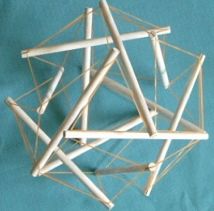| Back to Back Issues Page |
 |
|
The body is a tensegrity. What the heck is that? June 28, 2020 |
Hi,
With the summer now in full swing and COVID-19 still very much with us, I hope you and yours continue to be safe and well. This newsletter will continue to cover topics barely talked about anywhere else and will always try to offer actionable tools to help you feel better now. With my in-person practice closed indefinitely, my sole focus is on making available online what I’ve learned during my thirty years of working with clients suffering from chronic pain.
IN THIS ISSUE• The Body is a Tensegrity• Stretching Blueprint near completion
The body is a tensegrity. What the heck is that?The term tensegrity was coined by philosopher and architect, Buckminister Fuller. It is an architectural concept that combines the words, tension and integrity. This is a tensegrity structure:
The wooden dowels are suspended and connected by rubber bands. If any dowel or any rubber band moves, the whole structure is affected. Our bodies are like that. Our bodies are, in fact, tensegrity structures. Why is this important? It’s important because too often pain is the result of a complex push and pull of forces in the body as opposed to some localized defect. Perhaps the most common defect we think of is a spinal disc problem, like a bulge or a herniation, causing back pain. Can bulges and herniations cause back pain? Of course they can. But these represent a very small percentage of cases relative to the huge number of individuals who suffer from significant, and even debilitating, back pain who show no evidence of disc problems. Much more frequent is this scenario: An individual consults their doctor about back pain (or shoulder, neck, or other pain), is told their Xrays, MRIs, or other tests, are normal, and then faces a blank look — or worse, a dismissive look -- from a physician who can’t find anything wrong. Without “proof” the physician doesn’t have anything to go on. Unless, of course, they understand that the body is a tensegrity. What this means in practical terms is that we can have pain in one location that is caused by tightness or restriction in another location. A very common example is lower back pain caused by tightness in the hamstrings. If the hamstrings are tight and short, the pelvis is, in effect, fixed in place disallowing a natural pelvic swing. This can cause strain to the lower back. Another example is neck pain caused by shoulder muscle tightness. If the shoulders are rounded due to tight muscles of internal rotation, the upper trapezius has no choice but to brace. This bracing inhibits the ability to turn one’s head and forces the smaller neck muscles to overwork to accomplish simple movements. Over time these smaller neck muscles will become very fatigued and sore and sometimes will become extremely painful. The important point, here, is that we must adopt a global, integrated approach in order to both understand and resolve unexplained pain. The first step is realizing that the body is NOT a mechanistic assemblage of parts but an elegant interplay of forces.
Action you can take right away1. From head-to-toe identify each muscle or body region that is exceptionally tight and inflexible.2. IMPORTANT: Make sure you have explored the whole body and not just the most obvious areas. Identifying the "hidden" areas of tightness is a big part of a successful strategy. 3. Create a list of the top 5 and order them: the least flexible, the next least flexible, etc. 4. Commit to stretching these top 5 twice per day, morning and night, using a gentle, repeated 2-second stretch rather than static stretching. It's helpful to actually count out loud, 1-1000, 2-1000. 5. Perform 7-10 reps for the tightest muscles and 5-7 reps for those that are somewhat less tight. 6. Try to set aside a mindset of "No Pain, No Gain." While useful in athletic training, this mindset is not useful in the context of relieving pain and trying to improve flexibility.
Stretching Blueprint Near CompletionThe first course to be released from my new learning platform, Relieving That Pain Online Courses, is near completion. The course is called:and Better Flexibility This course is a complete guide to Active Isolated Stretching, a surprisingly easy way to relieve aches and pain, boost energy and improve flexibility. Instead of remaining stuck on what I call the treadmill of re-aggravation that many experience with static stretching, Active Isolated Stretching offers an alternative… A gentle but incredibly effectively method to coax muscles to let go and lengthen, to release their tension, and to do so before your very eyes. For many, adding Active Isolated Stretching to a regime of daily self-care will be all that’s needed to resolve many persistent aches and pains that haven’t responded to static stretching. But for those whose pain is more severe and stubborn, we must resolve postural distortion. This will be subject of the second course to be released this summer which will provide clear guidance for correcting the two primary postural distortion patterns you’ve heard me speak of before: the RALF Pattern and the H-FLEX Pattern. Creation of these courses has gotten a recent injection of talent from my stepson who is completing his BFA in film at Emerson College, and his partner, a graduate of the Berklee School of Music. They have returned home for the summer and I’ve hired them to bring their intelligence and numerous skills to help me. (Thank Heaven!) Needless to say, we are moving much faster as a team than I could progress alone, and the finished products, I believe, will be much better for it. That’s all for now! All the best, Stephen
|
| Back to Back Issues Page |
